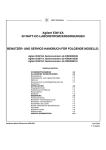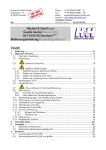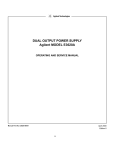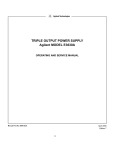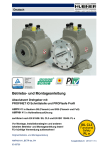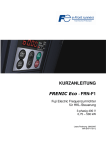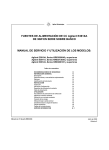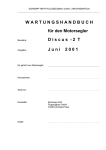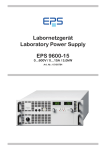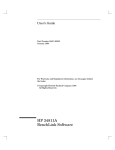Download E361xA Netzgeräte - Stromversorgungen
Transcript
Authorized Distributor Agilent E361XA 30 WATT-DC-LABORSTROMVERSORGUNGEN BENUTZER- UND SERVICE-HANDBUCH FÜR FOLGENDE MODELLE: Agilent E3610A Agilent E3611A Agilent E3612A Inhaltsverzeichnis SICHERHEITSHINWEISE ALLGEMEINE INFORMATIONEN Beschreibung Spezifikationen und ergänzende Daten Optionen Seriennummer und Gültigkeitsbereich des Handbuchs INSTALLATION Eingangskontrolle Aufstellung und Kühlung Netzanschluss Netzkabel BEDIENUNG Funktionsprüfung Betriebsart “Konstantspannung” Betriebsart “Konstantstrom” Anschließen der Lasten Betrieb außerhalb der Spezifikationen Impulslast Kapazitive Lasten Rückstromlast SERVICE-INFORMATIONEN Handbuch Agilent-Teilenummer 5959-5304 3-2 3-2 3-2 3-3 3-4 3-4 3-4 3-4 3-4 3-4 3-4 3-5 3-5 3-5 3-5 3-6 3-6 3-6 3-6 3-6 A-1 Oktober 2007 6. Ausgabe bestimmte Bauteile weiterhin Hochspannung führen. Zur Vermeidung von Stromschlägen müssen das Gerät vom Stromnetz trennen, spannungsführende Bauteile entladen und etwaige externe Spannungen abtrennen, bevor Sie Bauteile berühren. SICHERHEITSHINWEISE Die nachstehenden allgemeinen Sicherheitsrichtlinien müssen bei der Bedienung, Wartung oder Reparatur des Gerätes unbedingt beachtet werden. Das Nichtbeachten der Richtlinien oder besonderer Warnungen an anderen Stellen dieses Handbuchs verstößt gegen Sicherheitsstandards, Herstellervorschriften und vorgesehene Betriebsweise des Geräts. Agilent Technologies übernimmt keine Verantwortung für Schäden, die durch Nichtbeachten dieser Richtlinien entstehen. SICHERHEITSSYMBOLE Benutzerhandbuch-Symbol. Dieses Symbol ist an sicherheitsrelevanten Stellen des Gerätes angebracht. Es bedeutet, daß die diesbezüglichen Hinweise im Bedienungshandbuch beachtet werden sollen. ! Vor dem Anschluss an das Stromnetz Vergewissern Sie sich, dass das Gerät auf die örtliche Netzspannung eingestellt ist. oder Gerät erden. Dies ist ein Gerät der Schutzklasse 1 (mit Schutzerde-Anschluß). Zur Vermeidung von Stromschlaggefahr müssen das Chassis und das Gehäuse des Gerätes geerdet werden. Das Gerät muss über ein dreiadriges Netzkabel an eine Netzsteckdose mit Schutzkontakt angeschlossen werden. Bei Verwendung eines Verlängerungskabels muss eine durchgehende Schutzleiterverbindung vom Gerät bis zur Steckdose gewährleistet sein. Wenn das Gerät über einen Spartransformator betrieben wird, muss sichergestellt werden, dass der Bezugspunkt des Spartransformators an den Neutralleiter (Erde) des Stromnetzes angeschlossen ist. WARNUNG Nicht in explosiver Atmosphäre betreiben Dieses Gerät darf nicht in Gegenwart von entzündbaren Gasen oder Dämpfen betrieben werden. VORSICHT VON HOCHSPANNUNGSFÜHRENDEN TEILEN FERN BLEIBEN! Das Gehäuse des Gerätes darf nur von einem qualifizierten Techniker geöffnet werden. Der Austausch von Bauteilen sowie interne Justierungen dürfen nur von einem qualifizierten Techniker durchgeführt werden. Vor dem Austauschen von Bauteilen muss das Gerät vom Stromnetz getrennt werden. Unter Umständen können auch bei abgetrenntem Netzkabel ALLGEMEINE INFORMATIONEN Dieses Symbol kennzeichnet den Erd- (Masse-) anschluss. Das WARNUNG-Symbol weist auf Bedienungsschritte, Anwendungen und dergleichen hin, die bei unsachgemäßer Ausführung eine Verletzung oder den Tod des Benutzers zur Folge haben können. Führen Sie die nach einer WARNUNG beschriebenen Maßnahmen erst dann aus, wenn Sie die Warnung inhaltlich verstanden und die erforderlichen Sicherheitsmaßnahmen getroffen haben. Das VORSICHT-Symbol weist auf Bedienungsschritte, Anwendungen und dergleichen hin, bei deren unsachgemäßer Ausführung das Gerät beschädigt werden kann. Führen Sie die nach einem solchen Hinweis beschriebenen Maßnahmen erst dann aus, wenn Sie den Hinweis inhaltlich verstanden und die erforderlichen Sicherheitsmaßnahmen getroffen haben. In der Betriebsart “Konstantstrom” können Sie mit dem Drehknopf VOLTAGE den Spannungsbegrenzungswert-einstellen. In der Betriebsart “Konstantspannung” können Sie mit dem Drehknopf CURRENT den Strombegrenzungswert einstellen. Die Taste CC SET ermöglicht es. mit dem Drehknopf CURRENT den Strombegrenzungswert einzustellen, ohne den Ausgang kurzschließen zu müssen. Beschreibung Dieses Benutzer- und Service-Handbuch gilt für die Stromversorgungen Agilent E3610A, E3611A und E3612A. Alle Modelle sind kompakte, vielseitige Stromversorgungen mit zwei Bereichen, die sich insbesondere für Anwendungen im Rahmen der Entwicklung von (analogen oder digitalen) ICBaugruppen eignen. Falls nicht ausdrücklich anders vermerkt, beziehen sich die in diesem Handbuch enthaltenen Informationen auf alle drei Modelle. Der gewünschte Ausgangsbereich wird mit der Taste RANGE gewählt. Ausgangsspannung und Ausgangsstrom sind in jedem der beiden Bereiche kontinuierlich einstellbar. Die Frontplatte enthält numerische Ausgangsspannungs- und Ausgangsstrom-Anzeigen. Die Ausgangsspannung wird 3 1/ 2-stellig (E3611A: dreistellig) angezeigt und der Ausgangsstrom dreistellig. Die Ausgangswertebereiche finden Sie unter “Spezifikationen”. 3-2 Spezifikationen und ergänzende Daten EINGANGSSPANNUNG: *ÜBERLASTUNGSSCHUTZ: 115 Vac ± 10%, 47-63 Hz, 0,8 A, 70 W 100 Vac ± 10%, 47-63 Hz, 0,8 A, 70 W 230 Vac ± 10%, 47-63 Hz, 0,4 A, 70 W Eine ständig wirksame Strombegrenzung schützt die Stromversorgung gegen jede Art von Überlastung einschließlich Kurzschluss der Ausgangsanschlüsse. In der Betriebsart “Konstantstrom” wird die Ausgangsspannung von der Konstantspannungsschaltung begrenzt. AUSGANG:E3610A: 0 bis 8 V, 0 bis 3 A oder 0 bis 15 V, 0 bis 2 A E3611A: 0 bis 20 V, 0 bis 1,5 A oder 0 bis 35 V, 0 bis 0,85 A E3612A: 0 bis 60 V, 0 bis 0,5 A oder 0 bis 120V, bis 0,25 A *AUSGANGSANSCHLÜSSE: Die Frontplatte enthält drei Ausgangsanschlüsse. Alle diese Anschlüsse sind gegenüber der Chassis-Masse isoliert. Ein beliebiger dieser Anschlüsse kann mit der Chassis-Masse verbunden werden. LASTREGELUNG: *AUSGANGSCHARAKTERISTIKEN Betriebsart “Konstantspannung”: Besser als 0,01% + 2 mV für Laststromänderung von Volllast auf Null. Betriebsart “Konstantstrom”: Besser als 0,01% + 1 mA für Ausgangsspannungsänderung von Null auf Maximum. Spannung PA max 30 Watt NETZREGELUNG: Betriebsart “Konstantspannung”: Besser als 0,01% + 2 mV für beliebige Netzspannungsänderung innerhalb des zulässigen Bereichs. Betriebsart “Konstantstrom”: Besser als 0,01% 1 mA für beliebige Netzspannungsänderung innerhalb des zulässigen Bereichs. Strom WELLIGKEIT UND RAUSCHEN: Betriebsart “Konstantspannung”: Kleiner als 200 uV eff bzw. 2 mV SpitzeSpitze (20 Hz - 20 MHz) Betriebsart “Konstantstrom”: Kleiner als 200 uA eff bzw. 1 mA SpitzeSpitze (20 Hz - 20 MHz) HINWEIS: Im oberen Ausgangsstrombereich sind bei niedrigen Ausgangsströmen Ausgangsspannungen größer als V02 möglich. E3610A: V 01 = 15 V V02 = 8 V I01 = 2 A l02 = 3 A E3611A: V01 = 35 V V02 = 20 V I01 = 0,85 A l02 = 1,5 A E3612A: V 01 = 120 V V02 = 60 V I01 = 0,25 A l02 = 0,5 A TEMPERATURBEREICH: 0 to 40°C bei Volllast. Im Bereich von 40°C bis 55°C verringert sich der maximal zulässige Ausgangsstrom um 1%/°C. *ANZEIGEAUFLÖSUNG Betriebsart “Konstantspannung”: Kleiner als (0,02% + 1 mV)/°C. Betriebsart “Konstantstrom”: Kleiner als (0,02% + 2 mA)/°C. Spannung:E3610A E3611A E3612A Strom: E3610A E3611A E3612A EINSCHWINGZEIT: *ABWÄRTSPROGRAMMIERGESCHWINDIGKEIT: Ma- *TEMPERATURKOEFFIZIENT: 10 mV 100 mV 100 mV 10 mA 10 mA 1 mA ISOLATION: ± 240 Vdc ximaler Zeitbedarf für Ausgangsspannungsänderung von 100% auf 0,1% der maximalen Ausgangsspannung im Leerlauf. E3610A: maximal 2,5 s E3611A: maximal 1,0 s E3612A: maximal 1,5 s *AUSGANGSDRIFT: *AUFLÖSUNG: Minimale Schrittweite für Ausgangsspan- Nach einer Änderung des Ausgangsstroms von voller auf halbe Last (oder umgekehrt) benötigt die Stromversorgung weniger als 50 us, um wieder den vorigen Ausgangswert bis auf eine Abweichung von maximal 10 mV zu erreichen. Betriebsart “Konstantspannung”: Kleiner als 0,1% + 5 mV (über 8 Stunden, nach anfänglichem 30-minütigem Warmlaufen). Betriebsart “Konstantstrom”: Kleiner als 0,1% + 10 mA (über 8 Stunden, nach anfänglichem 30-minütigem Warmlaufen). nungs- oder Ausgangsstromänderung. E3610A: Spannung 10 mV Strom 5 mA E3611A: Spannung 10 mV Strom 5 mA E3612A: Spannung 100 mVStrom 0,5 mA KÜHLUNG: Das Gerät wird durch Konvektion gekühlt. GEWICHT: 3,8 kg netto, 4,2 kg einschließlich Verpackung. ANZEIGEGENAUIGKEIT: ±0,5% + 2 Digits bei 25°C ± 5°C (HINWEIS) * ERGÄNZENDE DATEN 3-3 Abbildung 1: ABMESSUNGEN Optionen versorgung zum Kundendienst zurückschicken, befestigen Sie daran bitte einen Anhänger mit Angabe des Eigentümers und der Modellnummer. Fügen Sie außerdem eine kurze Problembeschreibung bei. Folgende Optionen stehen zur Auswahl: Option Beschreibung OEM Eingangsspannung: 115 Vac +/-10%, 47-63 Hz, einphasig OE3 Eingangsspannung: 230 Vac +/-10%, 47-63 Hz, einphasig OE9 Eingangsspannung: 100 Vac +/-10%, 47-63 Hz, einphasig Es wird empfohlen, als Eingangskontrolle die in diesem Handbuch beschriebene “Funktionsprüfung” durchzuführen. Tests zum Verifizieren der Spezifikationen werden im Anhang beschrieben. Aufstellung und Kühlung Abbildung 1 zeigt den Umriss und die Abmessungen der Stromversorgung. Das Gerät wird einsatzbereit geliefert und braucht lediglich an das Stromnetz angeschlossen zu werden. Die Stromversorgung ist luftgekühlt. Lassen Sie hinter dem Gerät so viel Platz, dass ein ungehinderter Kühlluftstrom gewährleistet ist. Die Umgebungstemperatur sollte nicht mehr als 40°C betragen. Der maximale Ausgangsstrom verringert sich bei Temperaturen zwischen 40°C und 55°C um 1%/°C. Seriennummer und Gültigkeitsbereich des Handbuchs Stromversorgungen von Agilent Technologies werden durch eine eindeutige Seriennummer identifiziert. Der Code "MY" steht für das Herstellungsland Malaysia; die erste der nachfolgenden Ziffern steht für das Jahr (1=1991, 2=1992 usw.), die beiden nächsten für die Kalenderwoche. Die letzten fünf Ziffern bilden eine laufende Nummer. Falls die Seriennummer Ihrer Stromversorgung nicht in dem Bereich liegt, für den das Handbuch gilt (dieser ist auf der Titelseite des Handbuchs angegeben), liegt dem Handbuch eventuell ein gelbes Änderungsblatt bei, das die Unterschiede zwischen Ihrer und der im Handbuch beschriebenen Stromversorgung beschreibt. Netzanschluss INSTALLATION Netzkabel Die Stromversorgung ist (je nachdem, welche Netzspannungs-Option bestellt wurde) auf eine der unter “Spezifikationen” angegebenen Netzspannungen eingestellt. Zu jeder Netzspannungs-Option sind die Eingangsspannungsbereich, der Eingangsstrom und die Leistungsaufnahme angegeben. Dieses Gerät wird mit einem dreiadrigen Netzkabel geliefert. Wenn das Gerät über dieses dreiadrige Kabel an eine Schutzkontakt-Steckdose angeschlossen wird, ist eine ordnungsgemäße Schutzerdung gewährleistet. Das Gerät darf auf keinen Fall ohne Schutzerdung betrieben werden. Eingangskontrolle Wenn Sie Ihre Stromversorgung erhalten, sollten Sie sie zunächst auf äußerlich erkennbare Transportschäden untersuchen. Wenn ein solcher Schaden erkennbar ist, informieren Sie sofort den Spediteur und das nächstgelegene Vertriebsbüro von Agilent Technologies. Gewährleistungsinformationen finden Sie auf der inneren vorderen Umschlagseite dieses Handbuchs. Bewahren Sie die Originalverpackung auf für den Fall, dass Sie die Stromversorgung einmal an Agilent Technologies zurückschicken müssen. Wenn Sie die Strom- Die Stromversorgung wird mit einem den Normen des Bestimmungslandes entsprechenden Netzkabel geliefert. Falls Ihre Stromversorgung irrtümlich mit einem falschen Netzkabel geliefert wurde, setzen Sie sich bitte mit dem nächstgelegenen Vertriebs- und Service-Zentrum von Agilent Technologies in Verbindung. 3-4 Abbildung 2: BEDIENUNGSELEMENTE UND ANZEIGEN Betriebsart “Konstantspannung” BEDIENUNG Wenn Sie die Stromversorgung als Konstantspannungsquelle betreiben möchten, gehen Sie folgendermaßen vor: a. Schalten Sie die Stromversorgung ein, und stellen Sie (vor dem Anschließen der Last) mit dem Zehngang-Potentiometer VOLTAGE die gewünschten Ausgangsspannung ein. Die LED “CV” leuchtet. b. Drücken Sie die Taste CC SET, und stellen Sie mit dem Zehngang-Potentiometer CURRENT den maximal zulässigen Ausgangsstrom (Strombegrenzungswert) ein. Wenn in der Betriebsart “Konstantspannung” eine Laständerung zu einer Überschreitung des Strombegrenzungswertes führt, geht die Stromversorgung automatisch in die Betriebsart “Konstantstrom” über; die Ausgangsspannung sinkt dann entsprechend ab. Funktionsprüfung Nachfolgend wird beschrieben, wie die in Abbildung 2 gezeigten Bedienungselemente und Anzeigen benutzt werden. Außerdem wird ein kurzer Test beschrieben, mit dem Sie überprüfen können, ob die Stromversorgung ordnungsgemäß funktioniert. a. Bringen Sie den Netzschalter LINE in die Stellung ON. b. Wählen Sie mit der Taste RANGE den gewünschten Bereich. c. Drehen Sie den Drehknopf VOLTAGE gegen den Uhrzeigersinn bis zum Anschlag, und überprüfen Sie, ob die Ausgangsspannung auf Null zurückgeht. Drehen Sie anschließend den Drehknopf VOLTAGE im Uhrzeigersinn bis zum Anschlag, und überprüfen Sie, ob die Ausgangsspannung ihren Maximalwert erreicht. d. Drücken Sie die Taste CC SET und drehen Sie dabei den Drehknopf CURRENT zuerst gegen den Uhrzeigersinn bis zum Anschlag und dann im Uhrzeigersinn bis zum Anschlag; überprüfen Sie dabei, ober der Strombegrenzungswert im Bereich von Null bis zum spezifizierten Maximalwert eingestellt werden kann. e. Schließen Sie die Last an die Ausgangsanschlüsse der Stromversorgung an. Betriebsart “Konstantstrom” Wenn Sie die Stromversorgung als Konstantstromquelle betreiben möchten, gehen Sie folgendermaßen vor: a. Drehen Sie den Drehknopf CURRENT entgegen dem Uhrzeigersinn bis zum Anschlag (Ausgangsstrom 0 A), und schalten Sie dann die Stromversorgung ein. b. Stellen Sie (vor dem Anschließen der Last) mit dem Drehknopf VOLTAGE die maximal zulässige Ausgangsspannung (Spannungsbegrenzungswert) ein. Wenn in der Betriebsart “Konstantstrom” eine Laständerung zu einer Überschreitung des Spannungsbegrenzungswertes führt, geht die Stromversorgung automatisch in die Betriebsart “Konstantspannung” über und begrenzt die Ausgangsspannung auf den programmierten Spannungsbegrenzungswert; der Ausgangsstrom sinkt dann entsprechend ab. c. Drücken Sie die Taste CC SET, und stellen Sie mit dem Drehknopf CURRENT den gewünschten Ausgangsstrom ein (Die LED “CC” leuchtet erst nach dem Anschließen der Last). WARNUNG Stromschlaggefahr Trennen Sie das Gerät vor dem Anschließen einer Last vom Stromnetz ab. 3-5 Anschließen der Last(en) Kapazitive Last Der Ausgang der Stromversorgung ist gegenüber der Chassis-Masse isoliert. Einer der beiden Ausgangsanschlüsse kann mit Chassis-Masse oder mit einer externen Spannung bis zu 240 V verbunden werden. Parallel zu den Ausgangsklemmen der Stromversorgung liegt ein Kondensator, der im Konstantspannungsbetrieb Energiereserven für kurzzeitige Stromspitzen bereitstellt. Eine zusätzliche externe Kapazität parallel zum Ausgang verbessert zwar die “Standfähigkeit” der Stromversorgung bei pulsförmiger Belastung, beeinträchtigt jedoch die Schutzfunktion der internen Strombegrenzung. In diesem Fall kann ein starker Stromimpuls die Last beschädigen, bevor der mittlere Ausgangsstrom so weit angestiegen ist, dass der Überstromschutz anspricht. Falls Sie mehrere Lasten an der Stromversorgung betreiben möchten, schließen Sie diese jeweils über separate Leitungspaare an die Ausgangsanschlüsse der Stromversorgung an. Dadurch werden etwaige Rückwirkungen zwischen den Lasten minimiert, und die Vorzüge der niedrigen Ausgangsimpedanz der Stromversorgung kommen voll zur Geltung. Halten Sie die Lastleitungspaare so kurz wie möglich, und verdrillen Sie sie oder verwenden Sie abgeschirmte Leitungen, um Störeinstreuungen zu verringern. (Bei Verwendung einer Abschirmung sollte diese nur stromversorgungsseitig geerdet werden; lassen Sie das andere Ende der Abschirmung frei). Rückstromlast Wenn am Ausgang der Stromversorgung eine aktive Last angeschlossen ist, kann diese u. U. während bestimmter Betriebszustände einen Rückstrom in die Stromversorgung einspeisen. Es muss verhindert werden, dass eine externe Quelle einen Strom in die Stromversorgung einspeist, da sonst der Regelkreis eventuell nicht mehr ordnungsgemäß funktioniert und der Ausgangskondensator der Stromversorgung beschädigt werden kann. Deshalb muss der Ausgang der Stromversorgung mit einem “Dummy”-Widerstand belastet werden, der dafür sorgt, dass die Stromversorgung während des gesamten Betriebszyklus der Last Strom liefert. Betrieb außerhalb der Spezifikationen Mit den Drehknöpfen VOLTAGE und CURRENT können Sie Ausgangsspannungen bzw. Ausgangsströme einstellen, welche die spezifizierten Maximalwerte um bis zu 5% überschreiten. Die Stromversorgung wird dadurch nicht beschädigt; allerdings ist die Einhaltung der Spezifikationen dann nicht mehr gewährleistet. Pulsförmige Belastung Wenn der Ausgangsstrom den vorgegebenen Grenzwert überschreitet, geht die Stromversorgung automatisch vom Konstantspannungsbetrieb in den Strombegrenzungsbetrieb über. Auch wenn der eingestellte Strombegrenzungswert höher ist als der mittlere Ausgangsstrom, kann es bei pulsförmiger Belastung vorkommen, dass der Strombegrenzungswert überschritten wird und die Stromversorgung in die Betriebsart “Konstantstrom” umschaltet. Falls dies unerwünscht ist, stellen Sie den Strombegrenzungswert entsprechend dem Spitzenstrom (und nicht dem mittleren Strom) ein. 3-6 APPENDIX SERVICE INFORMATION Figure A-1. Block Diagram PRINCIPLES OF OPERATION Throughout this discussion, refer to both the block diagram of Figure A-1 and the schematic diagram at the rear of the manual. The input AC line voltage is stepped down by the power transformer and applied to the rectifier and filter. The rectifier-filter converts the AC input to raw DC which is fed to the positive output terminal via parallel series regulator(Q1 and Q3) and current sampling resistor(R2). The regulator, part of the feedback loop, is made to alter its conduction to maintain a constant output voltage or current. The voltage developed across the current sampling resistor is the input to the constant current error amplifier. The constant voltage error amplifier obtains its input by sampling the output voltage of the supply. Any changes in output voltage or current are detected, amplified by the error amplifier and driver and applied to the series regulator in the correct phase and amplitude to counteract the change in output voltage or current. Two error amplifiers are included in a CV/CC supply, one for controlling output voltage, the other for controlling output current. Since the constant voltage amplifier tends to achieve zero output impedance and alters the output current whenever the load resistance changes, while the constant current amplifier causes the output impedance to be infinite and changes the output voltage in response to any load resistance change, it is obvious that the two amplifiers can not operate simultaneously. For any given value of load resistance, the power supply must act either as a constant voltage source or as a constant current source - it can not be both; transfer between these two modes is accomplished at a value of load resistance equal to the ratio of the output voltage control setting to the output current control setting. The reference and bias circuit provides stable reference voltages which are used by the constant voltage/current error amplifier circuits for comparison purpose. The digital meter circuit provides an indication of output voltage and current for constant voltage or constant current operating modes. The display power circuit provides voltage which is used by A/D converter and LED drive. Diode CR3 is connected across the output terminals in reverse polarity. It protects the output electrolytic capacitor and the series regulator transistor from the effects of s reverse voltage applied across the output terminals. PERFORMANCE TEST The following provides the test procedure in high current range for verifying the unit's compliance with the specifications and characteristics of Table in page 1-3. The same test procedure may be applied to low current range. Test Equipment Required The following Table lists the equipment required to perform the tests and adjustments. You can separately identify the equipment for performance tests, or calibration in the USE column of the Table. A-1 Table A-1. Test Equipment Required TYPE REQUIRED CHARACTERISTICS USE RECOMMENDED MODEL Oscilloscope Sensitivity: 1 mV Bandwidth: 20 MHz/100 MHz P RMS Voltmeter True rms, 10 MHz bandwidth P Multimeter Resolution: 0.1 mV Accuracy: 0.01% P, A Agilent 34401A Electronic Load Voltage Range : 240 Vdc Current Renge : 10 Adc Open and short switches Transient on/off P, A Agilent 6063B Load Resistor(For high current range) 2.6 ohm 50 W, 13.3 ohm 50 W, 120 ohm 50 W P Current Sampling Resistor 0.1 ohm 0.1% 10 W, 1 ohm 1% 10 W P, A * P = Performance testing Constant Voltage(CV) Test The measuring device must be connected as close to the output terminals as possible when measuring the output impedance, transient response, regulation, or ripple of the power supply in order to achieve valid measurements. A measurement made across the load includes the impedance of the leads to the load and such leed lengths can have an impedance several orders of magnitude greater than the supply output impedance, thus invalidating the measurement. Agilent 54602A A = Calibration adjustments. c. Turn up output voltage to the full rated value (E3610A: 8.0 V, E3611A: 20 V, E3612A: 60 V) as read on the digital voltmeter. Then input on the electronic load. d. Record the output voltage at the digital voltmeter. e. Operate the electronic load in Open(Input Off) mode. f. Record the output voltage again immediately. The readings’ difference during the immediate change should not more than 0.01% of output voltage plus 2 mV. When performance measurements are made at the front terminals, the load should be plugged into the front of the terminals at (B), while the monitoring device is connected to a small lead or bus wire inserted through the hole in the neck of the binding post at (A). Load Effect(Load Regulation) Definition: CV Load Effect is the immediate change in dc output voltage when load resistance changes from open circuit to full load or from full load to open circuit. Test Parameters: Measured Variable: Output Voltage Expected Results: Less than 0.01% plus 2 mV Test Procedure: a. Connect the test equipment as shown in Figure A-2. Operate the electronic load in constant current mode and set its current to the full rated value of the power supply (E3610A: 3.0 A, E3611A: 1.5 A, E3612A: 0.5 A). Input off the electronic load. b. Turn the unit's power on and turn CURRENT control fully clockwise. A-2 Figure A-2. Basic Test Setup Source Effect(Line Regulation) Definition: Source effect is the immediate change in dc output voltage when the ac input voltage changes from a minimum to maximum value (± 10%of nominal voltage). Test Parameter: Measured Variable: Output Voltage Expected Results: Less than 0.01% plus 2 mV Test Procedure: a. Connect the test equipment as shown in Figure A-2. Operate the electronic load in constant current mode and set its current b. c. d. e. f. g. to the full rated value of power supply. Input off the electronic load. Connect the unit to the ac power line through a variable autotransformer which is set for low line voltage (104 Vac for 115 Vac). Turn the unit’s power on and turn CURRENT control fully clock-wise. Turn up output voltage to the full rated values as read on the digital voltmeter. Then input on the electronic load. Record the output voltage at the digital voltmeter. Adjust autotransformer to high line voltage (127 Vac for 115 Vac). Record the output voltage again immediately. The readings’ difference during the immediate change should not more than 0.01% of output voltage plus 2 mV. e. Set the oscilloscope for ac coupling, internal sync and lock on either the positive or negative load transient. f. Adjust the oscilloscope to display transients as in Figure A-3. g. Check that the pulse width of the transients at 10 mV from the base line is no more than 50 usec as shown. PARD(Ripple and Noise) Definition: Periodic and random deviation(PARD) in the unit's output ripple and noise combine to produce a residual ac voltage superimposed on the dc output voltage. Constant voltage PARD is specified as the root-mean-square(rms) or peak-to-peak(pp) output voltage in a frequency range of 20 Hz to 20 MHz. PARD(RMS) Measurement Load Transient Recovery Time Definition: This is the time for the output voltage to return to within a specified bend around its voltage following a step change in load. Test Parameters: Measured Variable: Output Voltage Transients Expected Results: Less than 50 usec (at 10 mV from base line) Test Procedure: a. Connect the test equipment as shown in Figure A-2, but replace the DVM with the oscilloscope. Operate the electronic load in constant current mode. b. Turn the unit's power on and turn CURRENT control fully clockwise. c. Turn up output voltage to the full rated value. d. Set the electronic load to transient operation mode between one half of unit's full rated value and unit's full rated value at a 1 KHz rate with 50% duty cycle. Test Parameter: Measured Variable: Output Voltage(rms) Expected Results: Less than 200 uV rms Test Procedure: a. Connect the test equipment as shown in Figure A-4. b. Turn the unit's power on and turn CURRENT control fully clockwise. c. Turn up output voltage to the full rated value. Check that the unit's CV indicator remains lighted. Reduce VOLTAGE control if not lighted. d. Check that the rms noise voltage at the true rms voltmeter is no more than 200 uV. Figure A-3. Load Transient Recovery Waveform A-3 the load current is fed to the extremes of the wire leading to the resistor while the sampling terminals are located as close as possible to the resistance portion itself. Generally, any current sampling resistor should be of the low noise, low temperature coefficient type end should be used at no more than 5% of its rated power so that its temperature rise will be minimized. Load Effect(Load Regulation) Definition: CC Load Effect is the immediate change in dc output current when load resistance changes from short circuit to full load or from full load to short circuit. Test Parameter: Measured Variable: Output Current Expected Results: Less than 0.01% plus 1 mA Figure A-4. RMS Measurement Test Setup PARD(Peak-to-Peak) Measurement Test Parameter: Measured Variable: Output voltage(peak-to-peak) Expected Results: Less than 2 mV p-p Test Procedure: a. Connect the test equipment as shown in Figure A-5. b. Turn the unit's power on and turn CURRENT control fully clockwise. c. Turn up output voltage to the full rated value. Check that the unit's CV Indicator remains lighted. Reduce VOLTAGE control if not lighted. d. Set the oscilloscope to AC mode and bandwidth to 20 MHz. e. Check that the peak-to-peak noise is no more than 2 mV. Test Procedure: a. Connect the DVM across Rs in Figure A-2. Operate the electronic load in constant voltage mode and set its voltage to the full rated value of power supply. Input off the electronic load. b. Turn the unit's power on and turn VOLTAGE control fully clock wise and current control to the full rated value. Then input on the electronic load. c. Check that the AMPS display reads full rated values and CC indicator remains lighted. Reduce CURRENT control if not lighted. d. Record the voltage across Rs and convert it to current through dividing by Rs . e. Operate the electronic load in short(input short mode). f. Record voltage across Rs again immediately. The readings’ difference during the immediate change should not more than 0.01% of output current plus 1 mA. Source Effect(Line Regulation) Definition: Source Effect is the immediate change in dc output current when the ac input voltage changes from the minimum to maximum val ue(± 10% of nominal voltage). Test Parameter: Measured Variable: Output Current Expected Results: Less than 0.01% plus 1 mA Figure A-5. Peak-to-Peak Measurement Test Setup Constant Current(CC) Tests For output current measurements the current sampling resistor must be treated as a four terminal device. In the manner of a meter shunt, Test Procedure: a. Connect the DVM across Rs in Figure A-2. Operate the electronic load in constant voltage mode and set its voltage to the full rated value of power supply. b. Connect the unit to the ac power line through a variable autotransformer that set for low line voltage(104 Vac for 115 Vec). Input off the electronic load. c. Turn the unit's power on and turn VOLTAGE control fully clock wise and output current to the full rated value. Then input on the electronic load. d. Check that the AMPS display reads full rated values and CC indicator remains lighted. Reduce CURRENT control if not lighted. e. Record output voltage across Rs and convert it to current through dividing by Rs. f. Adjust autotransformer to the high line voltage(127 Vac for 115 Vac). g. Record the voltage across Rs again immediately. The readings’ difference during the immediate change should not more than 0.01% of output current plus 1 mA. PARD(Ripple and Noise) Definition: Periodic and random deviation(PARD) in the unit's output ripple and noise combine to produce a residual ac current as well as A-4 an ac voltage superimposed on the dc output. Constant Current PARD is specified as the root-mean-square(rms) output current in e frequency range of 20 Hz to 20 MHz with the unit in CC operation. PARD(RMS) Measurement CALIBRATION PROCEDURE To calibrate ammeter and full scale current, connect test equipments as shown in Figure A-7. Test Parameter: Measured Variable: Output Current(rms) Expected Results: Less than 200 uA rms Test Procedure: a. Connect the test equipment as shown in Figure A-6. b. Turn the unit's power on and turn the VOLTAGE control fully clockwise. c. Turn up output current to the full rated value. Check that the CC indicator remains lighted. Reduce CURRENT control if not lighted. d. Record rms voltage across Rs and convert it to current through dividing by Rs. e. Check that the rms noise current is no more than 200 uA. PARD(Peak-to-Peak) Measurement Test Parameter: Measured Variable: Output Current(peak-to-peak) Expected Results: Less than 1 mA p-p Figure A-7. Calibration in High Current Range Test Procedure: a. Connect the test equipment as shown in Figure A-6, but replace the RMS voltmeter with oscilloscope. b. Set the oscilloscope to AC mode and bandwidth to 20 MHz. c. Turn the unit's power on and turn the VOLTAGE control fully clockwise. d. Turn up output current to the full rated value. Check that the CC indicator remains lighted. Reduce CURRENT control if not lighted. e. Record peak-to-peak voltage across Rs and convert it to current through dividing by Rs . Check that the peak-to-peak noise current is no more than 1 mA. Calibration in High Current Range a. Turn VOLTAGE and CURRENT control fully clockwise. b. Set RANGE push button to high current range. c. Turn on power supply and adjust R31 so that DVM indicates exactly as follows (5% over rated current): E3610A: 0.315 V E3611A: 0.158 V E3612A: 0.053 V d. Adjust R3 on the display board so that the displayed value on the front panel is equal to DVM value divided by Rs. e. While depressing CC SET push button, adjust R20 so that the displayed value on the front panel is equal to DVM value divided by Rs. Calibration in Low Current Range a. Set RANGE push button to low current range. b. Adjust R32 so that DVM indicates exactly as follows (5% over rated current). E3610A: 0.21 V E3611A: 0.089 V E3612A: 0.026 V Calibration of VOLTS Meter a. Disconnect the current shunt(Rs) and connect DVM across output of supply. b. Set RANGE push button to low current range at no load. c. Adjust VOLTAGE control till DVM indicates exactly as follows (full rated voltage): E3610A: 15 V Figure A-6. RMS Measurement Test setup E3611A: 35 V E3612A: 120 V d. Adjust R10 on the display board so that the value of the front panel display is the same as the value of DVM. A-5 s1 CERTIFICATION Agilent Technologies certifies that this product met its published specifications at time of shipment from the factory. Agilent further certifies that its calibration measurements are traceable to the United States National Institute of Standards and Technology (formerly National Bureau of Standards), to the extent allowed by that organization's calibration facility, and to the calibration facilities of other International Standards Organization members. WARRANTY This Agilent Technologies hardware product is warranted against defects in material and workmanship for a period of one year from date of delivery. Agilent software and firmware products, which are designated by Agilent for use with a hardware product and when properly installed on that hardware product, are warranted not to fail to execute their programming instructions due to defects in material and workmanship for a period of 90 days from date of delivery. During the warranty period, either Agilent or Agilent Technologies will, at its option, either repair or replace products which prove to be defective. Agilent does not warrant that operation the software, firmware, or hardware shall be uninterrupted or error free. For warranty service, with the exception of warranty options, this product must be returned to the nearest service center designated by Agilent. Customer shall prepay shipping charges by (and shall pay all duty and taxes) for products returned to Agilent for warranty service. Except for the products returned to Customer from another country, Agilent shall pay for return of products to Customer. Warranty services outside the country of initial purchase are included in Agilent's product price, only if Customer pays Agilent international prices (defined as destination local currency price, or U.S. or Geneva Export price). If Agilent is unable, within a reasonable time, to repair or replace any product to condition as warranted, the Customer shall be entitled to a refund of the purchase price upon return of the product to Agilent. The warranty period begins on the date of delivery or on the date of installation if installed by Agilent. LIMITATION OF WARRANTY The foregoing warranty shall not apply to defects resulting from improper or inadequate maintenance by the Customer, Customer-supplied software or interfacing, unauthorized modification or misuse, operation outside of the environmental specifications for the product, or improper site preparation and maintenance. TO THE EXTENT ALLOWED BY LOCAL LAW, NO OTHER WARRANTY IS EXPRESSED OR IMPLIED. AND AGILENT SPECIFICALLY DISCLAIMS THE IMPLIED WARRANTIES OF MERCHANTABILITY AND FITNESS FOR A PARTICULAR PURPOSE. For consumer transactions in Australia and New Zealand: The warranty terms contained in this statement, except to the extent lawfully permitted, do not exclude, restrict or modify and are in addition to the mandatory rights applicable to the sale of this product to you. EXCLUSIVE REMEDIES TO THE EXTENT ALLOWED BY LOCAL LAW, THE REMEDIES PROVIDED HEREIN ARE THE CUSTOMER'S SOLE AND EXCLUSIVE REMEDIES. AGILENT SHALL NOT BE LIABLE FOR ANY DIRECT, INDIRECT, SPECIAL, INCIDENTAL, OR CONSEQUENTIAL DAMAGES, WHETHER BASED ON CONTRACT, TORT, OR ANY OTHER LEGAL THEORY. ASSISTANCE The above statements apply only to the standard product warranty. Warranty options, extended support contacts, product maintenance agreements and customer assistance agreements are also available. Contact your nearest Agilent Technologies Sales and Service office for further information on Agilent's full line of Support Programs. DECLARATION OF CONFORMITY According to ISO/IEC Guide 22 and CEN/CENELEC EN 45014 Manufacturer’s Name and Addresss Responsible Party Agilent Technologies, Inc. 550 Clark Drive, Suite 101 Budd Lake, New Jersey 07828 USA Alternate Manufacturing Site Agilent Technologies (Malaysia) Sdn. Bhd Malaysia Manufacturing Bayan Lepas Free Industrial Zone, PH III 11900 Penang, Malaysia Declares under sole responsibility that the product as originally delivered Product Name: a) Single Output dc Power Supply (dual range) b) Single Output dc Power Supply (single range) c) Single Output System Power Supply d) Multiple Output dc Power Supply e) Multiple Output System dc Power Supply Model Number: a) E3610A, E3611A, E3612A b) E3614A, E3615A, E3616A, E3617A c) E3632A d) E3620A, E3630A e) E3631A Product Options: This declaration covers all options of the above product(s). Complies with the essential requirements of the Low Voltage Directive 73/23/EEC and the EMC Directive 89/336/EEC (including 93/68/EEC) and carries the CE Marking accordingly . EMC Information ISM Group 1 Class A Emissions As detailed in Electromagnetic Compatibility (EMC), Certificate of Conformance Number CC/TCF/00/102 based on Technical Construction File (TCF) ANJ12, dated Dec.20, 2000. Assessed by: Celestica Ltd, Appointed Competent Body Westfields House, West Avenue Kidsgrove, Stoke-on-Trent Straffordshire, ST7 1TL United Kingdom Safety Information and Conforms to the following safety standards. IEC 61010-1:2001 / EN 61010-1:2001 CSA C22.2 No. 1010.1:1992 This DoC applies to above-listed products placed on the EU market after: January 1, 2004 Date Bill Darcy/ Regulations Manager For further information, please contact your local Agilent Technologies sales office, agent or distributor, or Agilent Technologies Deutschland GmbH, Herrenberger Straβe 130, D71034 Böblingen, Germany Revision: B.00.00 Issue Date: Created on 11/24/2003 3:10 PM Document No. KIO_10-32.11.24doc.doc














